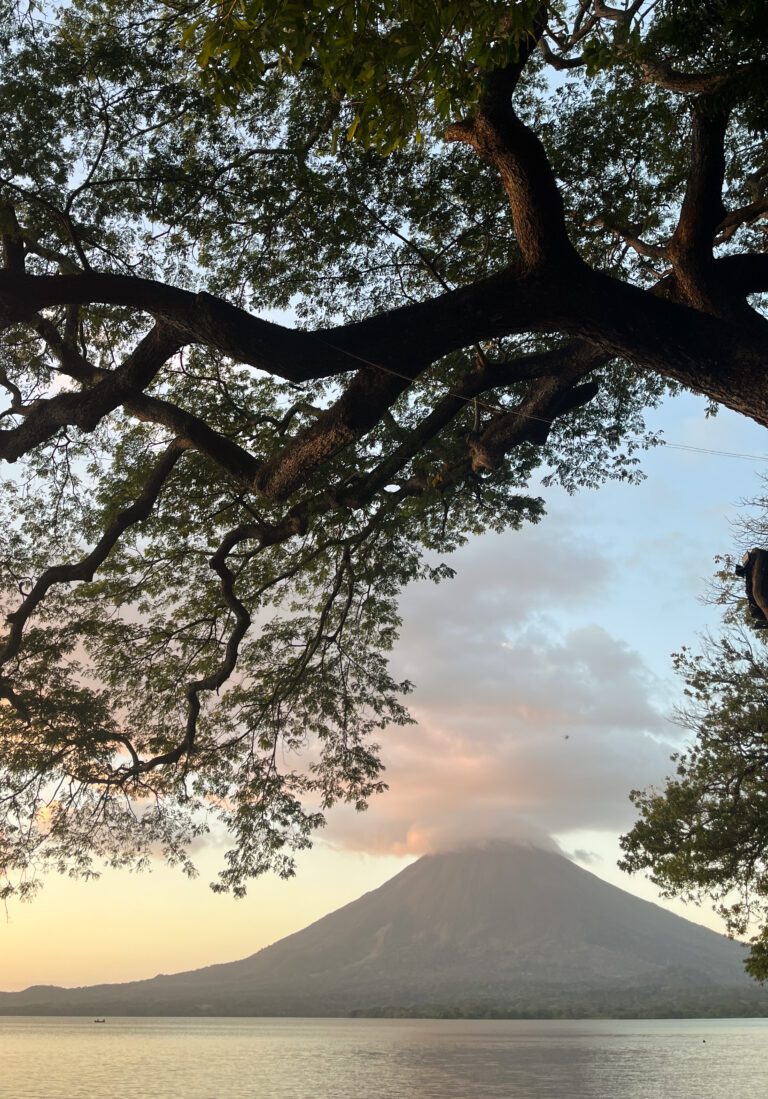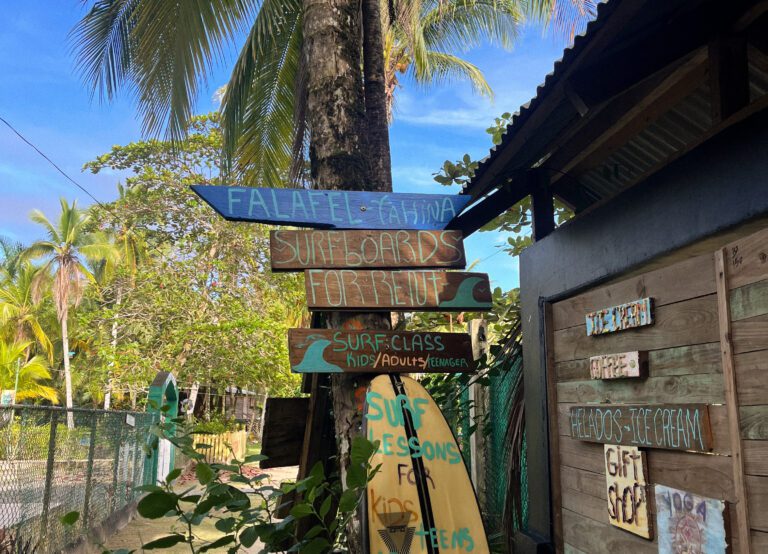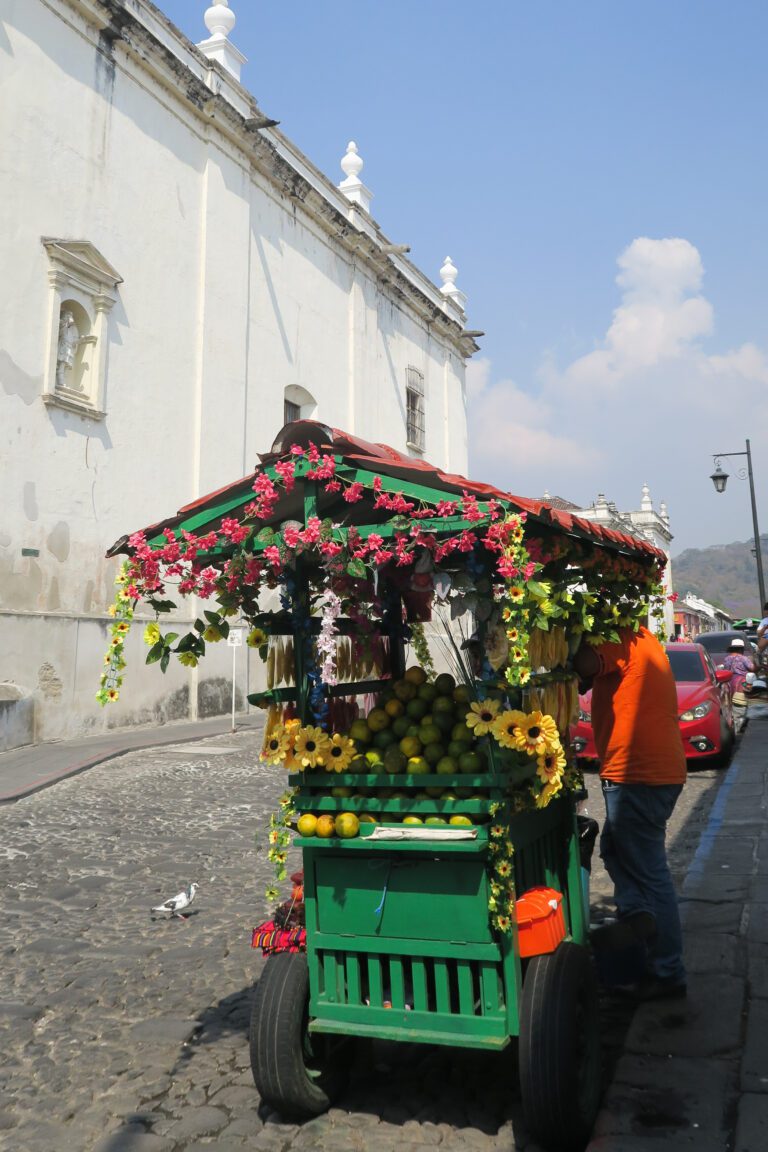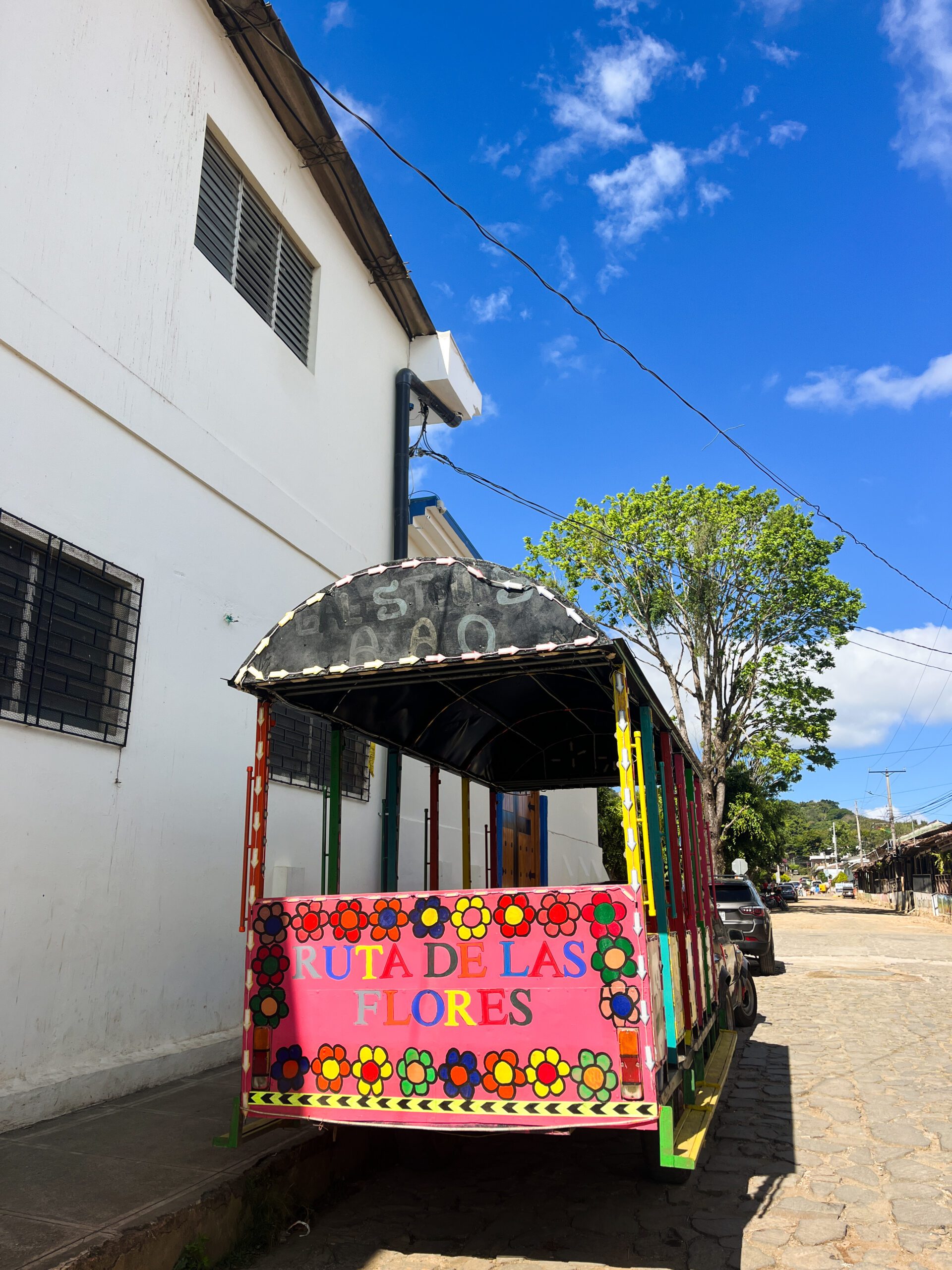
Ruta de las Flores, El Salvador: The Ultimate Travel Guide
One of the must-visit places when traveling El Salvador, is Ruta de las Flores. The 36 kilometer long road that goes through the western highlands of El Salvador, connecting 7 towns with each something different to experience. The name of the route comes from the flowers that covers the roadsides in the spring, making it a paradise for nature lovers and photographers. Traveling the Ruta de las Flores is about more than just the scenery, it’s a journey through Salvadoran culture. You can walk around artisan markets, taste world-class coffee straight from local plantations, hike waterfalls or join traditional festivals in towns like Juayúa and Ataco. The route is surprisingly easy to explore, whether you’re driving, taking a shuttle or going by bus.
In this guide, we’ll take you through everything you need to plan your trip along the Ruta de las Flores. We’ll walk you through each town, waterfalls, accommodations and other practical tips. At the end, you’ll have everything you need to make the most of your visit. For general travel prep, check our Travel Plan Checklist.
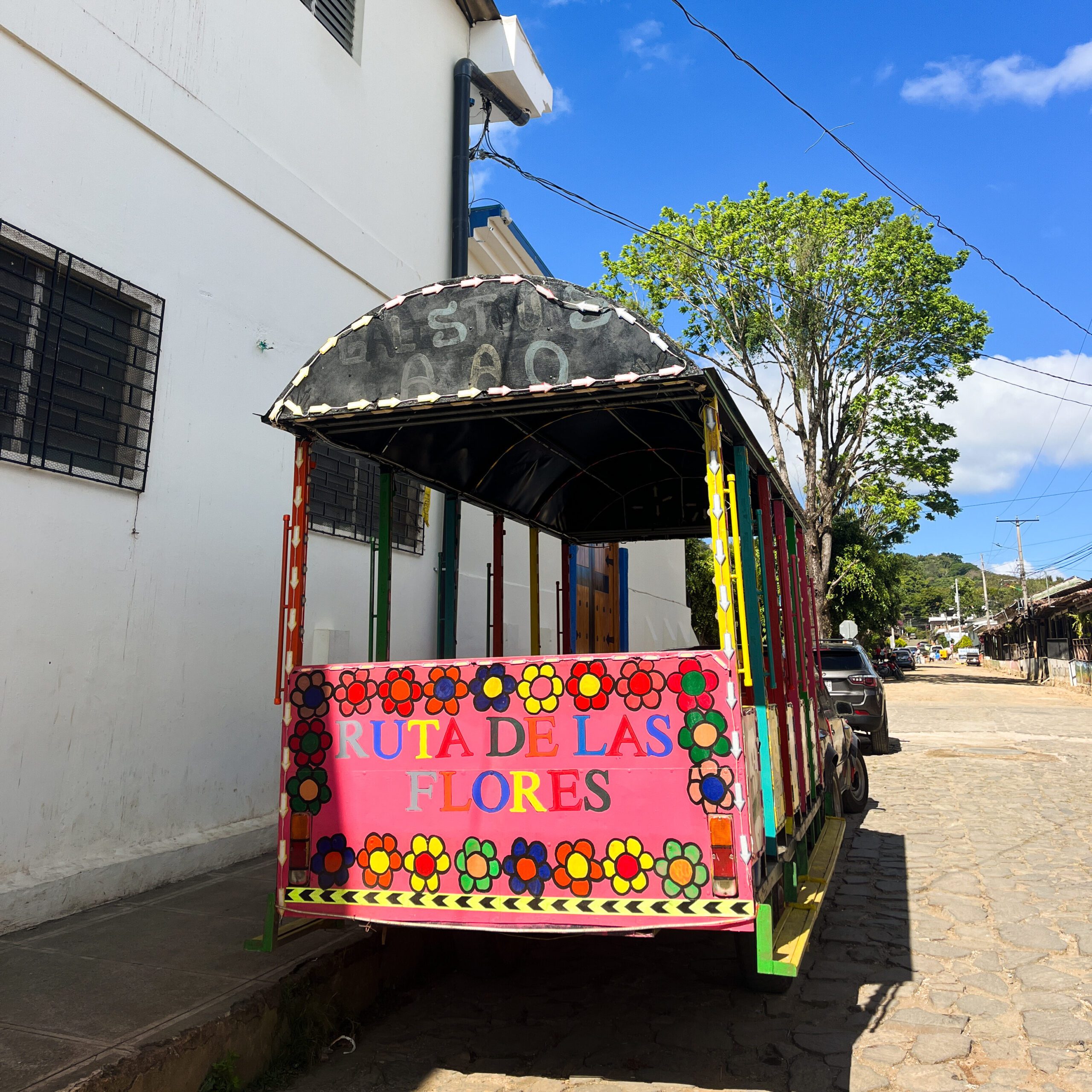
Just so you know: This post may contain affiliate links. That means we might earn a small commission if you book or buy something through the links – at no extra cost to you. It helps us keep sharing travel tips for budget adventures!
Towns Of The Route
Ruta de las Flores passes through the seven towns Sonsonate, Nahuizalco, Salcoatitán, Juayúa, Apaneca, Concepción de Ataco and Ahuachapán. You’ll often hear people say it’s five or seven towns, and both are correct. Some people leave out Sonsonate and Ahuachapán when talking about the route, as they’re less visited. However, they’re still part of the route and in this guide we’ll cover them as well.
Here’s a quick look at what makes each town worth a stop. Click any name to go directly to each section:
- Sonsonate: Quiet city that’s more of a gateway to the route. If you have time, explore its colonial center and local markets.
- Nahuizalco: Famous for its night market and artisan crafts, especially woven baskets and traditional textiles. The town has a charming colonial feel with cobblestone streets.
- Salcoatitán: One of the smaller towns on the route. Worth a stop to see its historic church and local life.
- Juayúa: Known for its Food Festival and beautiful waterfalls. Lively town with great cafes, murals and weekend markets.
- Apaneca: Adventure hotspot of the route with zip-lining, coffee tours and hiking through beautiful landscapes.
- Concepción de Ataco: Probably the most picture-perfect town with colorful murals, artisan shops and coffee farms. A must-visit for photography and local culture.
- Ahuachapán: Slightly off the main route for most tourists, but notable for hot springs and a more relaxed pace.
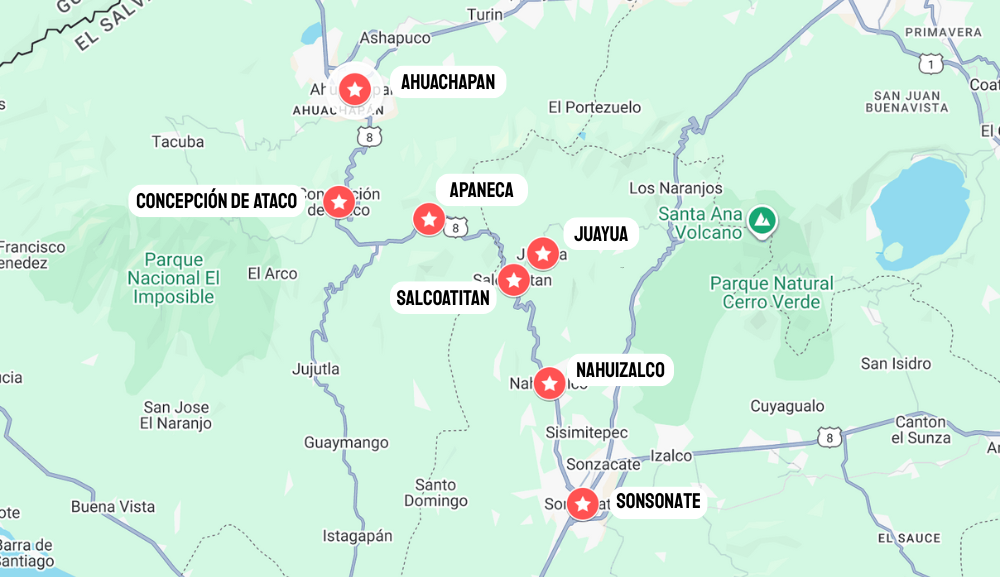
Best time to visit
Ruta de las Flores can be enjoyed almost any time of year, but the experience changes with the seasons. If you want to see the route when it’s the most spectacular, plan your trip between November and February. This is the start of the dry season and the time when the flowers that give the route its name often bloom. The exact time of when the flowers bloom varies from year to year. For that reason, it’s best to treat it as a bonus rather than a guarantee. And even though this may be the best time, it’s well worth a visit no matter what time of year you go.
For those who don’t mind some occasional rain, traveling outside the dry season (May to October) is also a great option. During this time the landscape gets green, the waterfalls are fuller and there is less tourists around.
If you have the opportunity, try to include a weekend in your visit. During the weekends the towns get more alive, specially in Juayúa, where the food festival fills the town with music and traditional dishes.
Since Ruta de las Flores is located in the mountains it means colder weather and fresher than the coast. For that reason it can be good to pack some light layers, even in the dry season. If you don’t have that in your packing, you can do some shopping in one of the second-hand stores in Juayúa, where you’ll find thrift shops and local markets selling clothes and accessories.
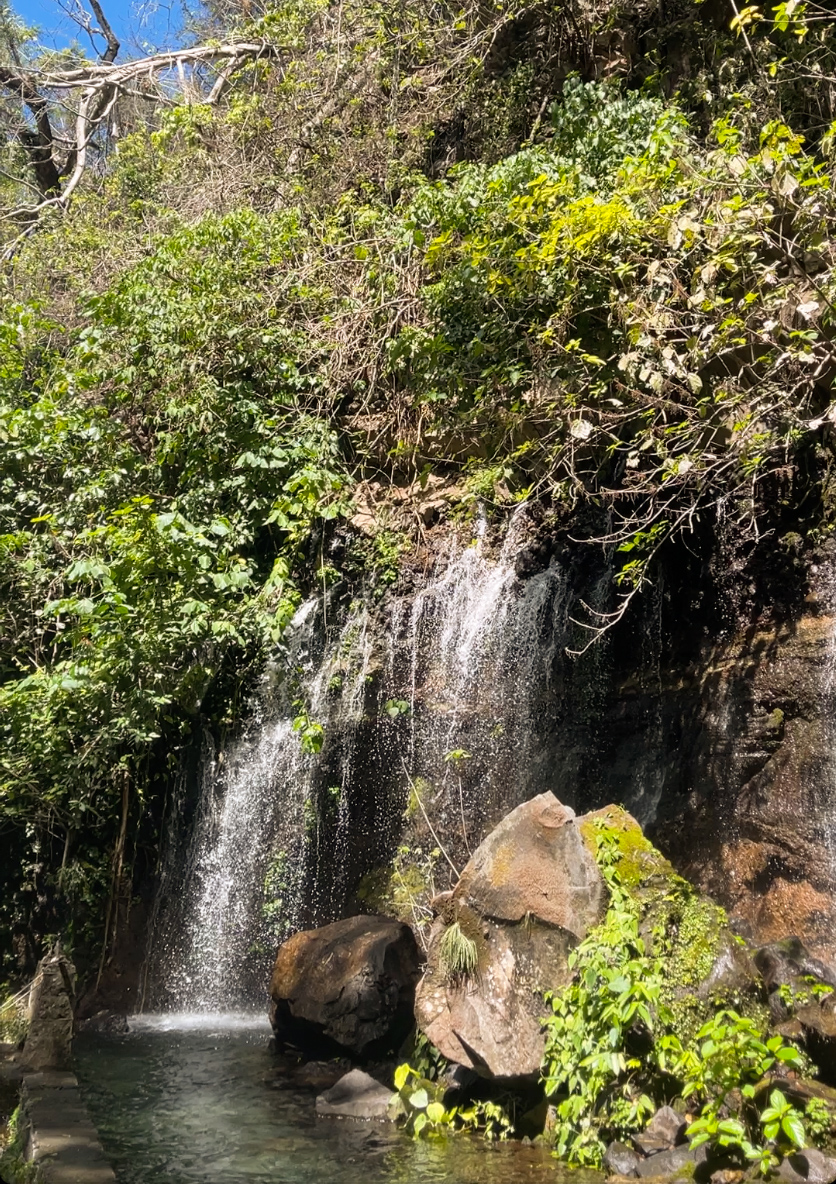
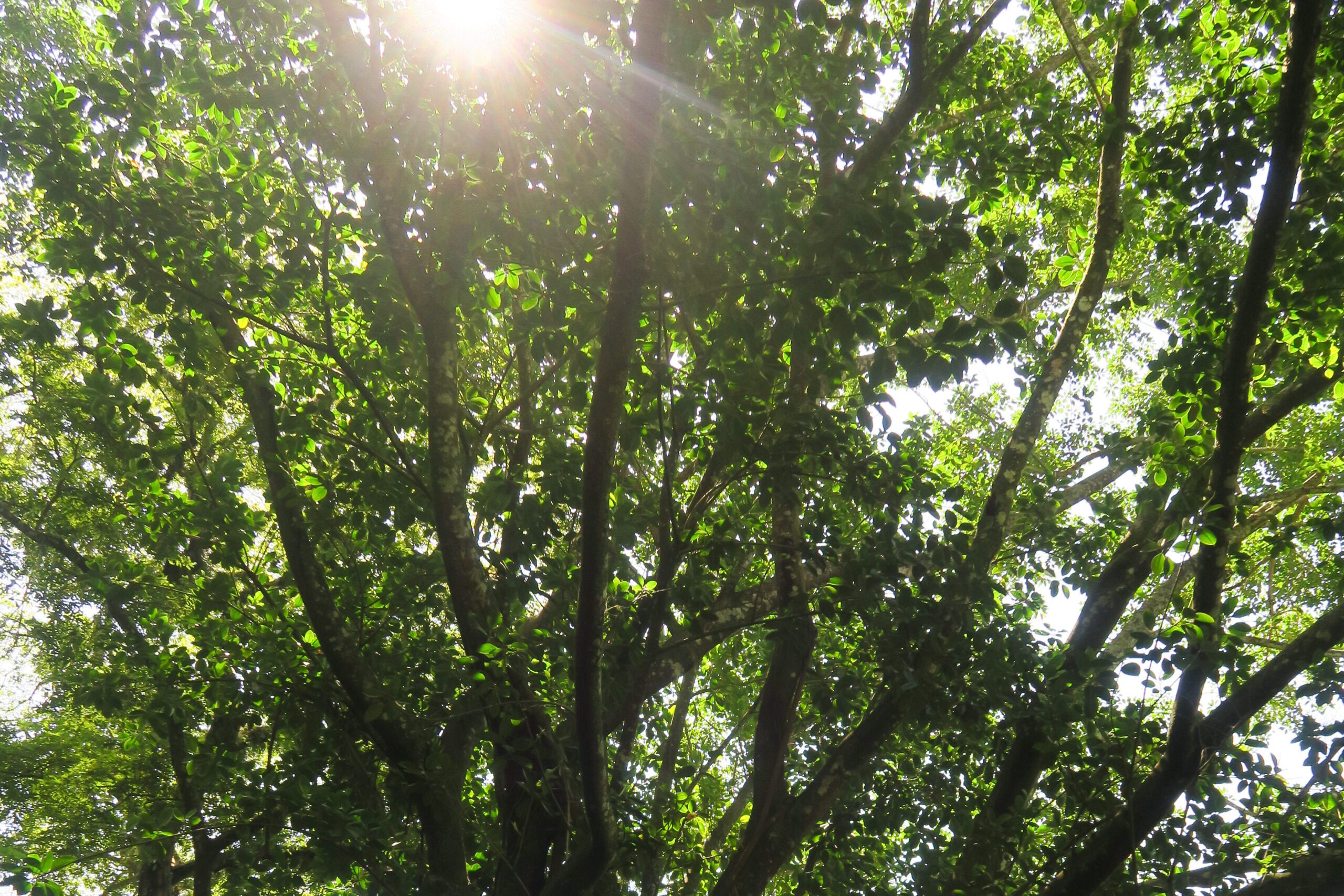
How To Get To Ruta De Las Flores
The route is located just a couple of hours from the most of El Salvador’s main destinations, so its pretty simple to reach. Whether you go with local buses, car or shuttle it’s very straight forward to get there.
Bus
- From San Salvador: From San Salvador you can catch the bus 205 from Terminal de Occidente to Sonsonate. When you reach Sonsonate, you’ll have to change to bus 249, which connects all the main towns along the route.
- From Santa Ana: From Santa Ana you can take a direct bus 238 from Bus Terminal Francisco Lara Pineda that goes directly to Juayúa. From there, you can take bus 249 north to Apaneca, Ataco, and Ahuachapán, or south to Salcoatitán and Nahuizalco.
- From the Coast (El Tunco / La Libertad): Take the bus 287 to Sonsonate. This bus only runs twice a day so make sure to check times in advance. Once in Sonsonate you’ll have to change to bus 249 that passes every town along the route. It might seem a little confusing, so check with your accommodation for the exact bus departure point and schedule.
Shuttle
If you’re coming from Guatemala or Honduras, it’s easiest to book a shuttle to Santa Ana through companies like Gecko Trails. There are no direct shuttles to Ruta de las Flores, so from there you’ll need to continue by bus, taxi or private transfer. It’s always best to ask around for different shuttle options, and you can also check if they’re able to drop you off along the route for a small extra fee.
Car / Motorcycle / Scooter
Driving gives you the most freedom to explore at your own pace. The trip from San Salvador or Santa Ana takes about 1.5 to 2 hours. The roads are usually in good condition, but can be tough during the rainy season. Since its less common with car rental options on the Ruta de las Flores, the easiest place to get a car is in San Salvador, Santa Ana, or at the international airport, just make sure to read reviews and check for hidden fees.
It’s much easier to find motorcycle and scooter rentals. If you decide to rent a bike in Santa Ana, we recommend Rick’s Rental for its great selection and affordable rates.
Tip: Weekends are often more busy. Make sure to arrive early to avoid crowds and limited parking at waterfalls and festivals.
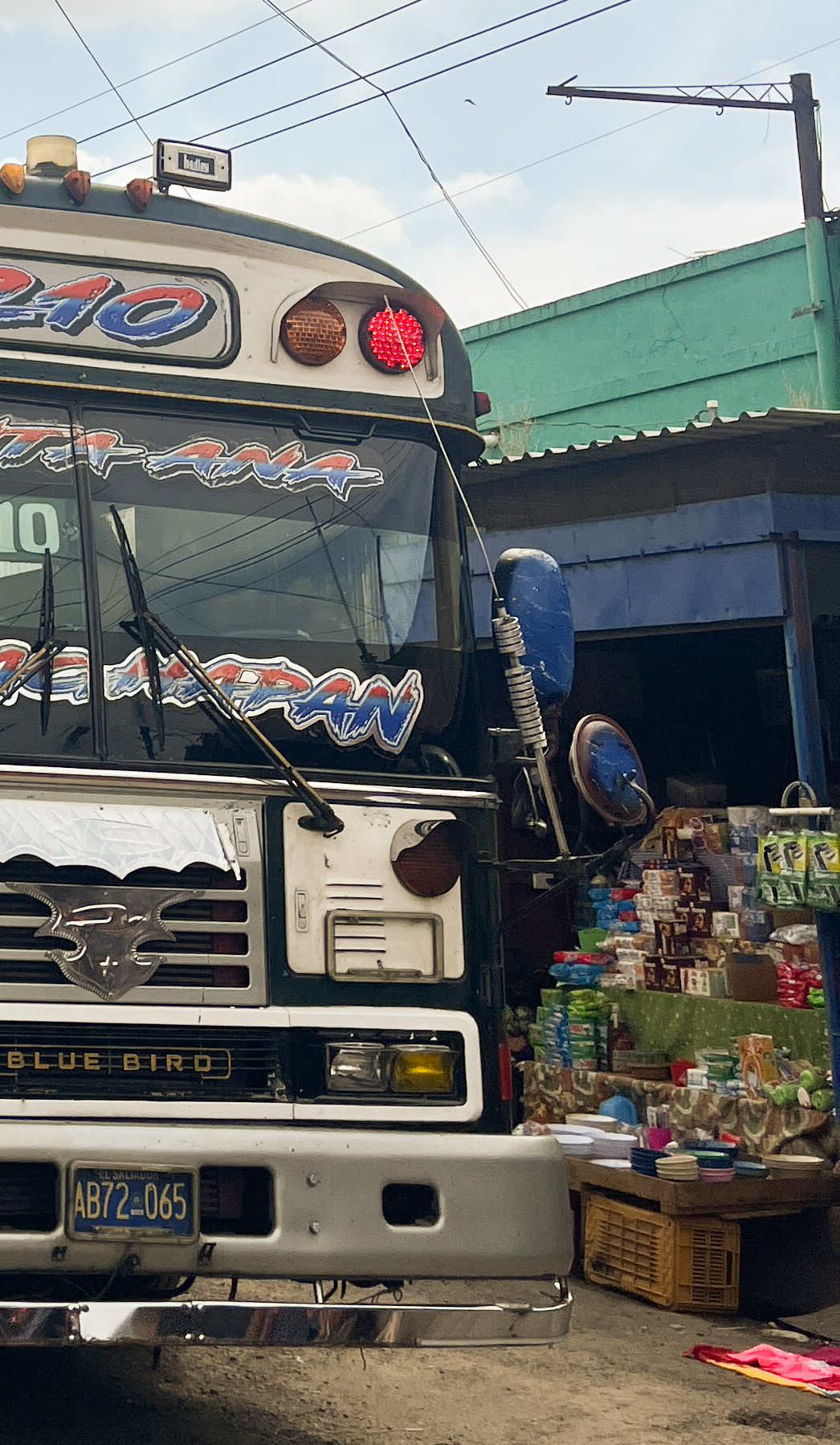

How To Get Around
Once you’ve made it to the Ruta de las Flores, getting between the towns is surprisingly easy. The villages are close to each other, the road is straightforward, and there are several ways to move around depending on your budget and travel style.
Local Bus
Going by local bus is the most affordable and common way to explore the route. Bus 249 connects the northern town of Ahuachapán with Sonsonate in the south, making stops at each of the towns along the route.
Travelers can plan their journey around attractions rather than schedules, hopping on and off at the towns that interest them most. Even locations slightly off the main road, such as Juayúa or nearby waterfalls, are accessible thanks to buses that detour into the towns or through local taxi connections.
Fares are low and buses runs consistently throughout the day, so this is a very affordable and reliable way of exploring the Ruta de las Flores.
Car / Motorcycle / Scooter
Driving by yourself gives you full freedom to explore at your own pace, as well as you can get more time to explore more places. Roads are generally good condition, but the detours to waterfalls or hot springs can be a big rough.
Parking is usually available in town centers, though weekends can get crowded specially in Juayúa and Ataco.
Car rentals along the Ruta de las Flores can be hard to find and its best to rent car in the bigger cities. There are several options for scooter rentals along the route. We personally rented from this motorcycle rental, which was a very pleasant experience with friendly staff and well maintained bikes.
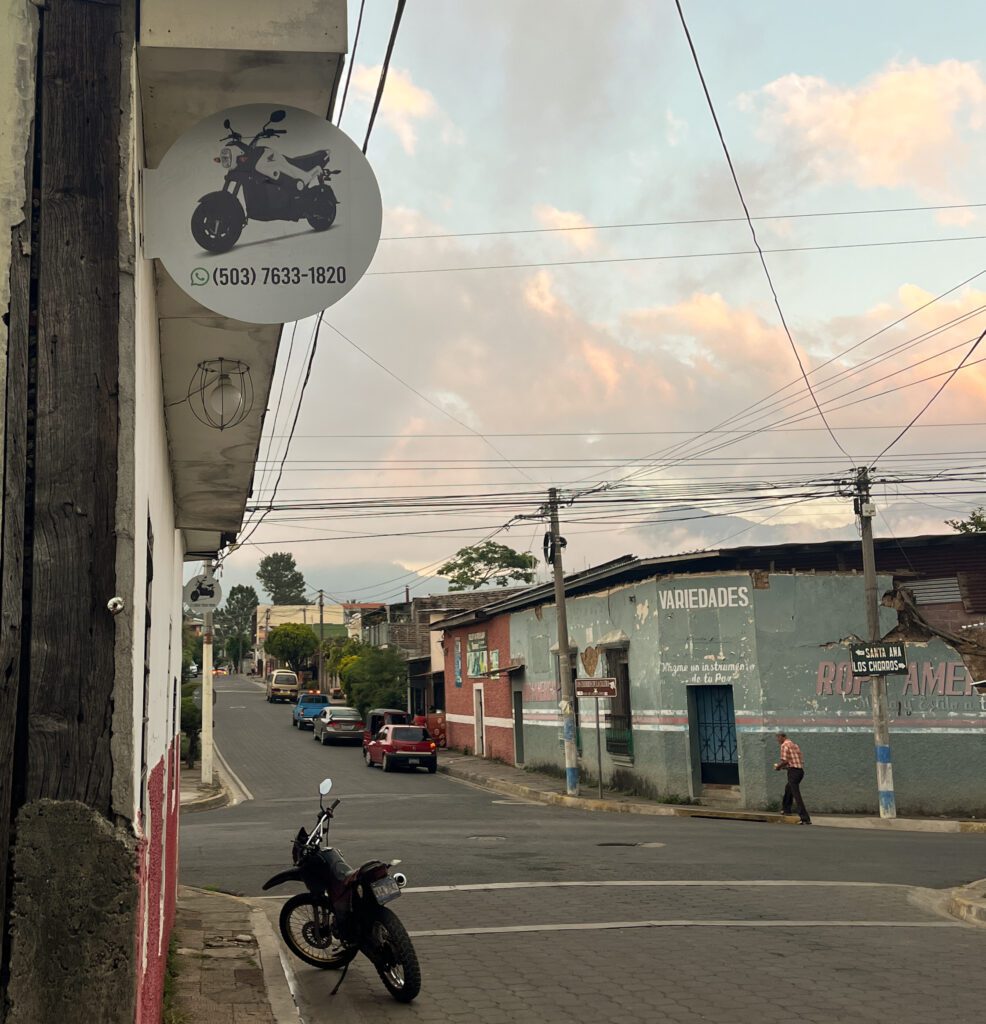
Tuk-tuks & Local Taxis
Inside each town, you’ll find tuk-tuks and small taxis for short trips to nearby waterfalls, hot springs or accommodations located outside the center. They’re cheap, quick and ideal if you don’t want to walk after a long day exploring.

Sonsonate
Sonsonate is seen as more of a gateway to the route than a main stop, and many travelers decide to skip it and instead head straight to the smaller towns. However, with its colonial history, traditional markets and religious traditions, a short stop here can give you a glimpse of daily life in western El Salvador. Even though it may not be too much things to explore it still has a charm that is more authentic and quite than the other towns of Ruta de las Flores.
Sonsonate is especially known for its Holy Week (Semana Santa) celebration. It is one of the most important religious events in the country and during this week the street gets filled with processions and music. Other highlights in Sonsonate include Santísima Trinidad Cathedral, a historic church that becomes the main spot during Holy Week, and the Plaza Ferroviaria, which shows the city’s old railway heritage. It also has a central market full of local produce, crafts and streetfood that reflect everyday Salvadoran life.
Because of its locations Sonsonate also makes a great base for exploring nearby destinations such as El Imposible National Park and the Pacific Coast beaches such as El Tunco and El Sunzal.
Things To Do In Sonsonate
- Parque Rafael Campo and the Catedral de Sonsonate: Visit the main square Parque Rafael Campo and the nearby Catedral de Sonsonate dedicated to Our Lady of the Holy Trinity.
- Mercado Central: Explore Mercado Central, perfect place to try local food, fresh fruit and and shop local textiles and handicrafts.
- Discover Nearby Attractions: Discover nearby highlights like El Imposible National Park or the Pacific Coast beaches such as El Tunco and El Sunzal.
Nahuizalco
Nahuizalco is located in the southern part of Ruta de las Flores and is a small town known for its strong indigenous Pipil heritage and traditional craftsmanship. The town is smaller and quieter than the neighbouring towns, but the authenticity of this place makes it worth a visit.
The most famous thing for Nahuizalco is the night market Mercado Nocturno that is held every weekend. During this event the streets get lit up and are full of music, food and handmade crafts. We went during the night market and would definitely recommend it. It was a really authentic experience and a nice way to see the town come alive.
During the days it’s calmer and you can walk around and visit the central plaza and the Parroquia San Juan Bautista church, see the colonial-style houses and cobblestone streets and also shop for handwoven wicker and tule crafts.
For a bit of nature, you can visit the nearby Cascada de la Golondrinera, which is a small waterfall perfect for a short hike or picnic.
Things To Do
- Mercado Nocturno: Visit the weekend night market for local food, music and handmade crafts.
- Parroquia San Juan Bautista and Central Plaza: Explore the church and the plaza at the center of town.
- Artisan Shops: Browse handwoven wicker baskets, tule crafts and other local textiles.
- La Cascada de la Golondrinera: Take a short trip to this nearby waterfall for a beautiful hike or picnic.
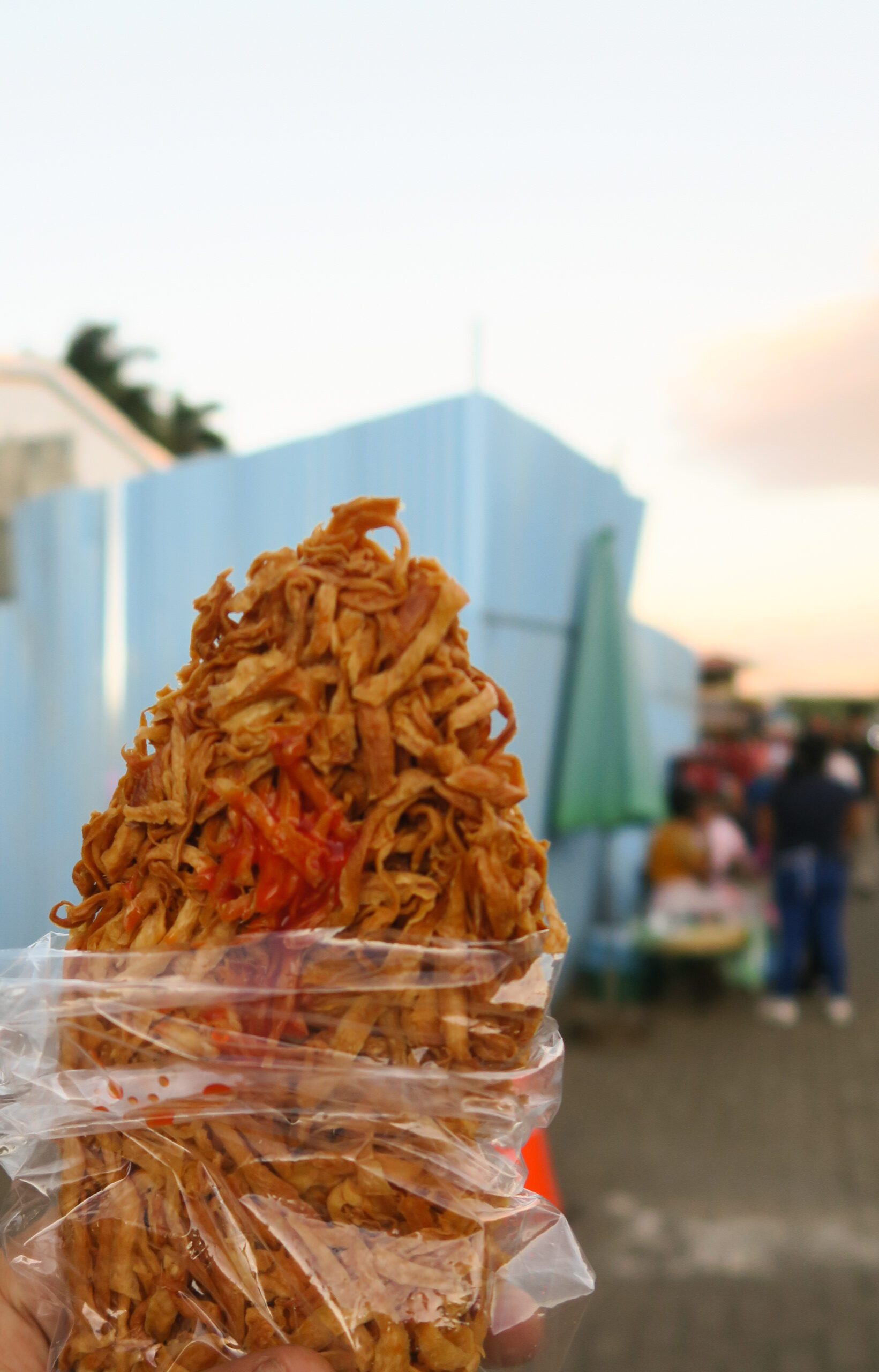
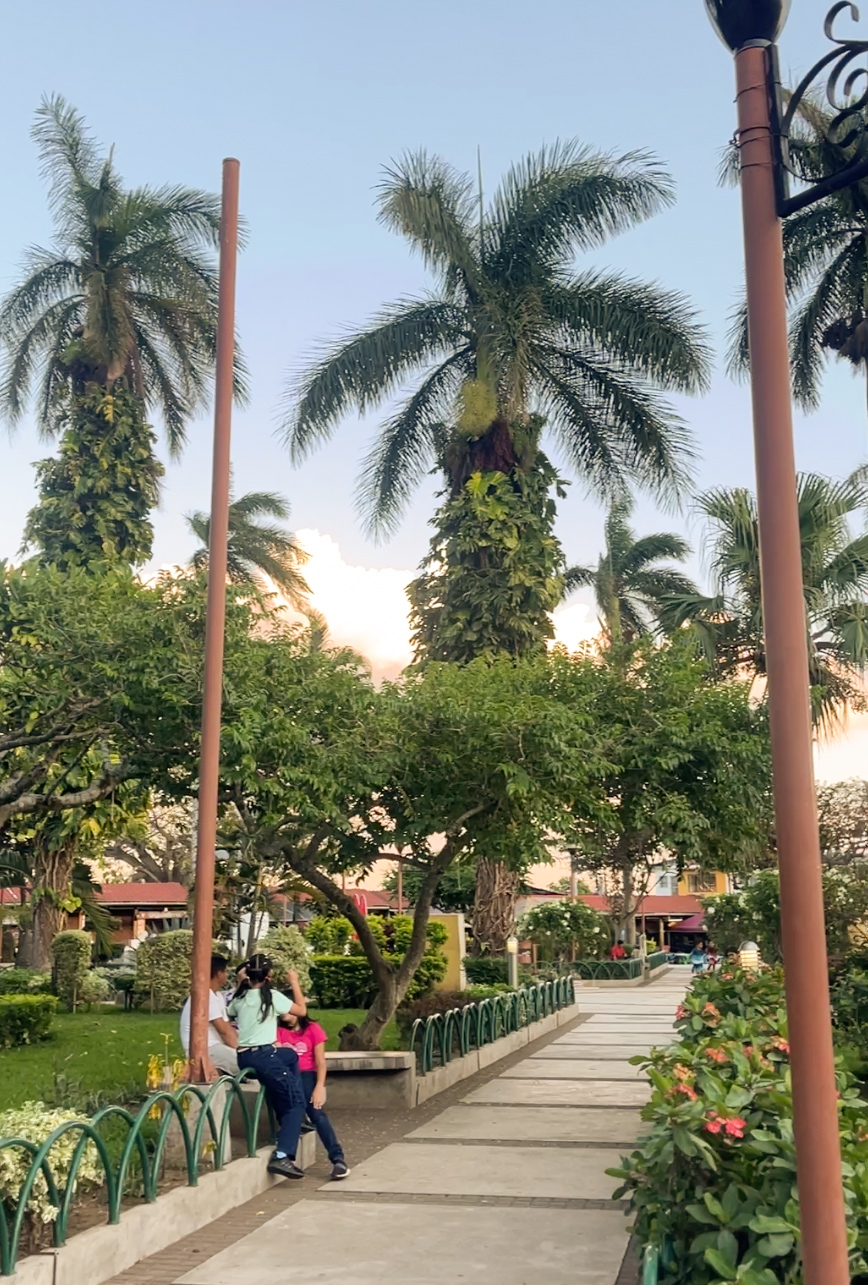
Salcoatitan
Nestled between Nahuizalco to the south and Juayúa to the north, Salcoatitán is one of the smallest towns along the Ruta de las Flores. What it lacks in size, it makes up for in coffee culture. While coffee is produced throughout the route, Salcoatitán is especially known for its local farms and family-run cafés, making it a perfect stop to taste authentic Salvadoran coffee.
A must-see landmark here is the ancient Ceiba tree, believed to date back to pre-Columbian times. It’s huge, centuries old, and a beautiful sight right on the center of the town. Nearby is also the Parque Central and Iglesia de San Miguel Arcángel that provides a lovely plaza area to explore, take photos or simply soak in the town’s relaxed vibe.
Salcoatitán is small and doesn’t have a long list of attractions, but a short visit is definitely worth it, especially if you love coffee, history or a glimpse of authentic small-town life on the Ruta de las Flores.
Things To Do In Salcoatitan:
- Ceiba Tree: Visit the ancient Ceiba tree that is one of the oldest in El Salvador.
- Parque Central: Relax at the central park and admire local street art.
- Iglesia de San Miguel Arcángel: Step inside the peaceful colonial church.
- Coffee Tasting: Try freshly brewed coffee from one of the local micro-roasters or cafés.
Juayúa
Located right in the heart of Ruta de las Flores is Juayúa. It’s one of the largest and liveliest towns on the route and a great base for exploring the surrounding villages. It is also full of restaurants, cozy cafés, supermarkets and with plenty of accommodation options.
Juayúa is best known for the Feria Gastronómica which is a weekend food festival. Every Saturday and Sunday, the towns plaza gets full of food and local flavours together with music and a festive atmosphere.
Beyond its food scene, Juayúa is also the starting point for the Ruta de las Siete Cascadas which is seven waterfalls hidden in the forest. It’s one of the highlights of the route and definitely worth adding to your itinerary. For something more relaxing, visit the Chorros de la Calera that is a set of beautiful cascades where you can take a dip after a day of exploring.
At the center of town, you’ll find the Iglesia Santa Lucía, a beautiful white church in the main square, perfect for sitting back and watching the town go about its day.
Things To Do In Juayúa
- Feria Gastronómica: Experience the weekend food festival with local dishes, live music and festive vibes.
- Parque Central and Iglesia Santa Lucía: Stroll around the central park and visit the beautiful white church in the main square.
- Ruta de las Siete Cascadas: Hike the trail through seven waterfalls where you can stop to swim and enjoy the refreshing pools along the way.
- Chorros de la Calera: Cool off at these nearby cascades, just a short walk from town.
- Cafés and Desserts: Enjoy Salvadoran coffee, sweets and treats at one of Juayúa’s cozy cafés.
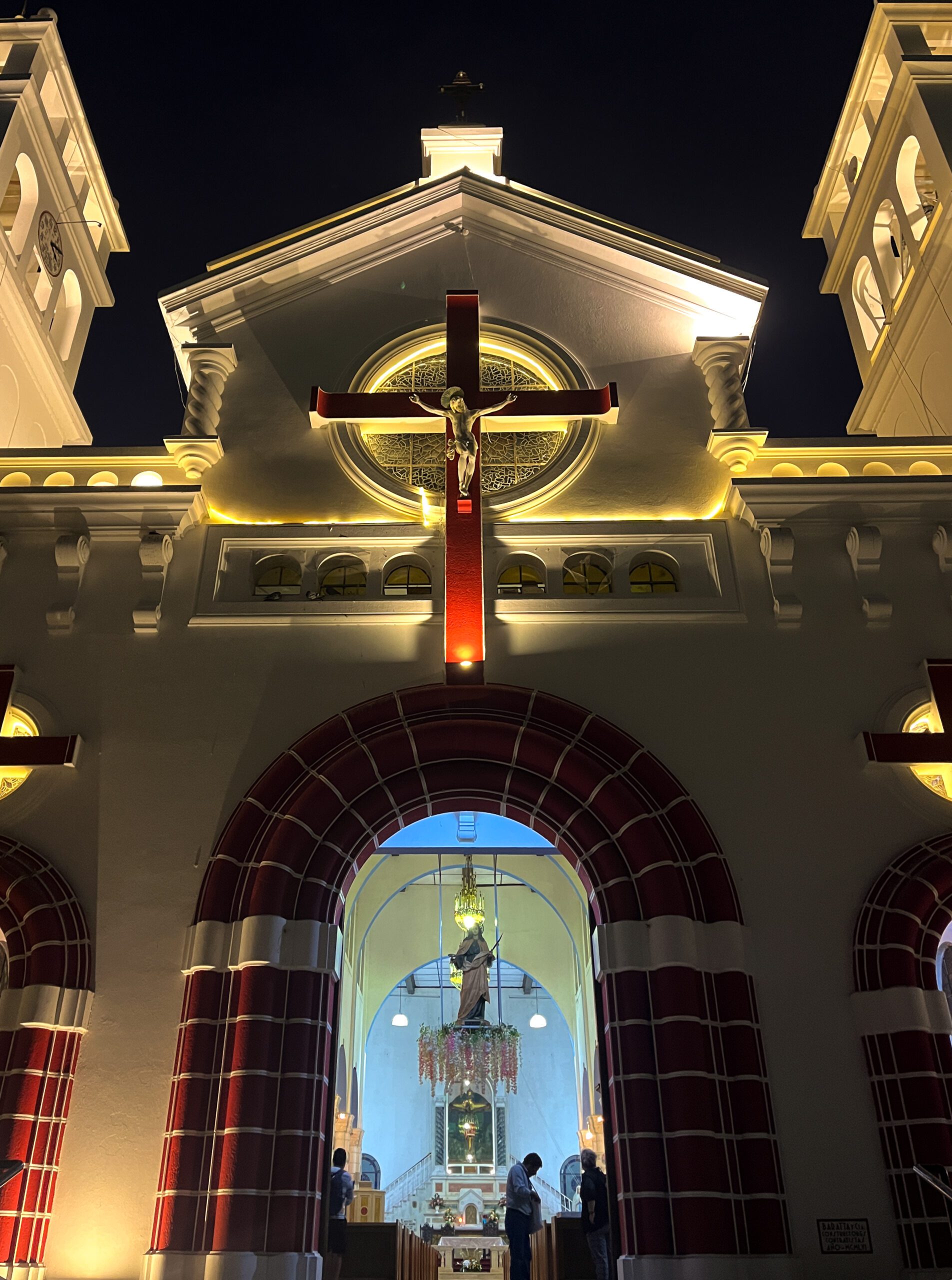
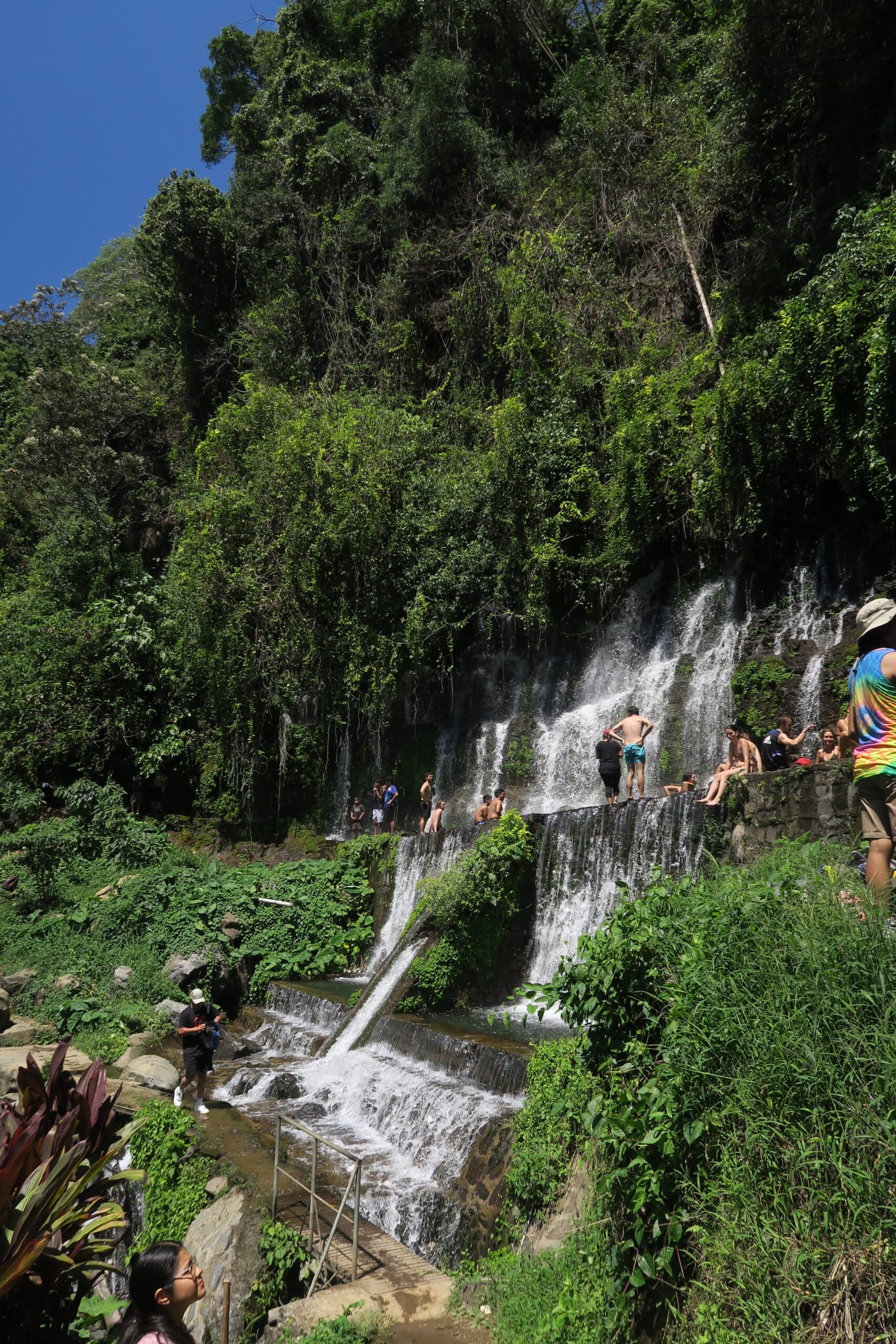
Apaneca
Apaneca is a mid-sized town, small but full of charm and surrounded by endless coffee plantations. The hills and open farmland make it one of the most scenic spots along Ruta de las Flores.
The town itself has a few highlights worth checking out, for example the big, white Iglesia San Andrés Apóstol that stands in the center and the colorful murals that is decorating the streets. Strolling around Parque Central is another thing to check out before heading out and exploring the nearby areas.
The areas around Apaneca are packed with things to do. Cafe Albania mixes coffee tasting with attractions such as rainbow slide, maze and zipline bike. There is also the options for dune buggy tours and ATV tours that takes you through the hills and plantations. You can also explore Laguna Verde and Laguna de las Ninfas, or discover hidden waterfalls like Cascadas de Don Juan.
Things To Do
- Parque Central and Iglesia San Andrés Apóstol: Relax in the central park and visit the white church in the heart of town.
- Café Albania: Taste freshly brewed coffee and enjoy attractions like the rainbow slide, maze and zipline bike.
- Mosaico Apaneca and Street Murals: Check out the colorful mosaic roundabout and murals around the streets.
- Adventure Tours: Experience ziplining or ATV tour through the coffee hills surrounding Apaneca.
- Laguna Verde and Laguna de las Ninfas: Explore these peaceful crater lakes just outside town.
- Cascadas de Don Juan: Hike to these waterfalls for a nature escape and a cool swim.

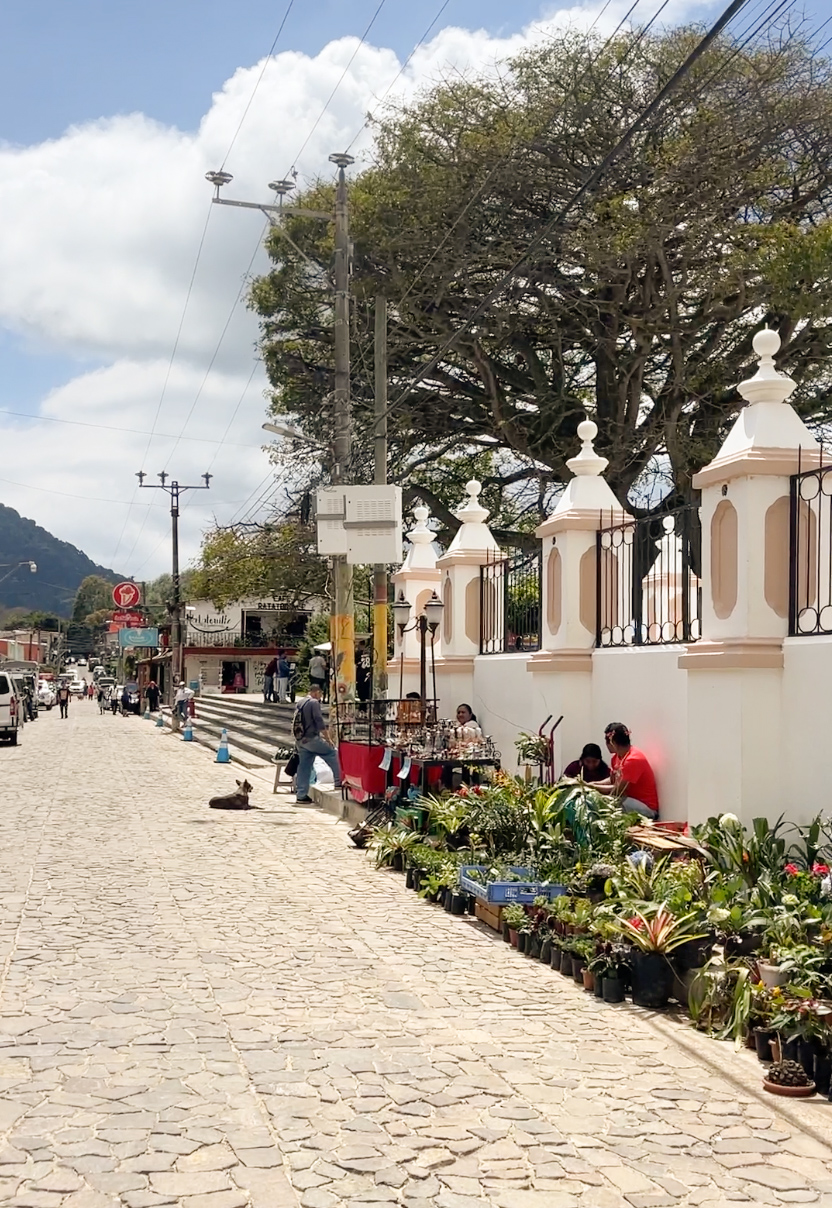
Concepción de Ataco
Concepción de Ataco, or just Ataco, is one of the most colorful towns on the Ruta de las Flores. Everywhere you look there’s street art, murals, mosaics and flags hanging between the buildings. It’s easily the most photogenic town on the route, and you can spend hours just wandering the streets and taking it all in.
Ataco ended up being our favorite town along the route. The town’s park, Parque Fray Rafael Fernández, is lively and the streets is full of artisan shops and market stalls where you can find local crafts. There is also a lot of cafes and restaurants around the town, as well as accommodation options. There is also the Mirador de la Cruz that gives a great view over the town and the closeby countryside.
Even though Ataco is small, it has lots of places to stay for all budgets, and it’s a great base for exploring the rest of the Ruta de las Flores.
Things To Do
- Parque Fray Rafael Fernández: Stroll through the park and check nearby artisan shops and stalls.
- Santuario Inmaculada Concepción de María: Visit the church in the town’s main square.
- Mirador de la Cruz: Walk up to this viewpoint for views over Ataco and the surrounding hills.
- Coffee Tours: Visit nearby plantations to learn about the coffee-making process and taste fresh local brews.
- Murals and Street Art: Walk the streets to see Ataco’s famous street art, mosaics and decorations around every corner.
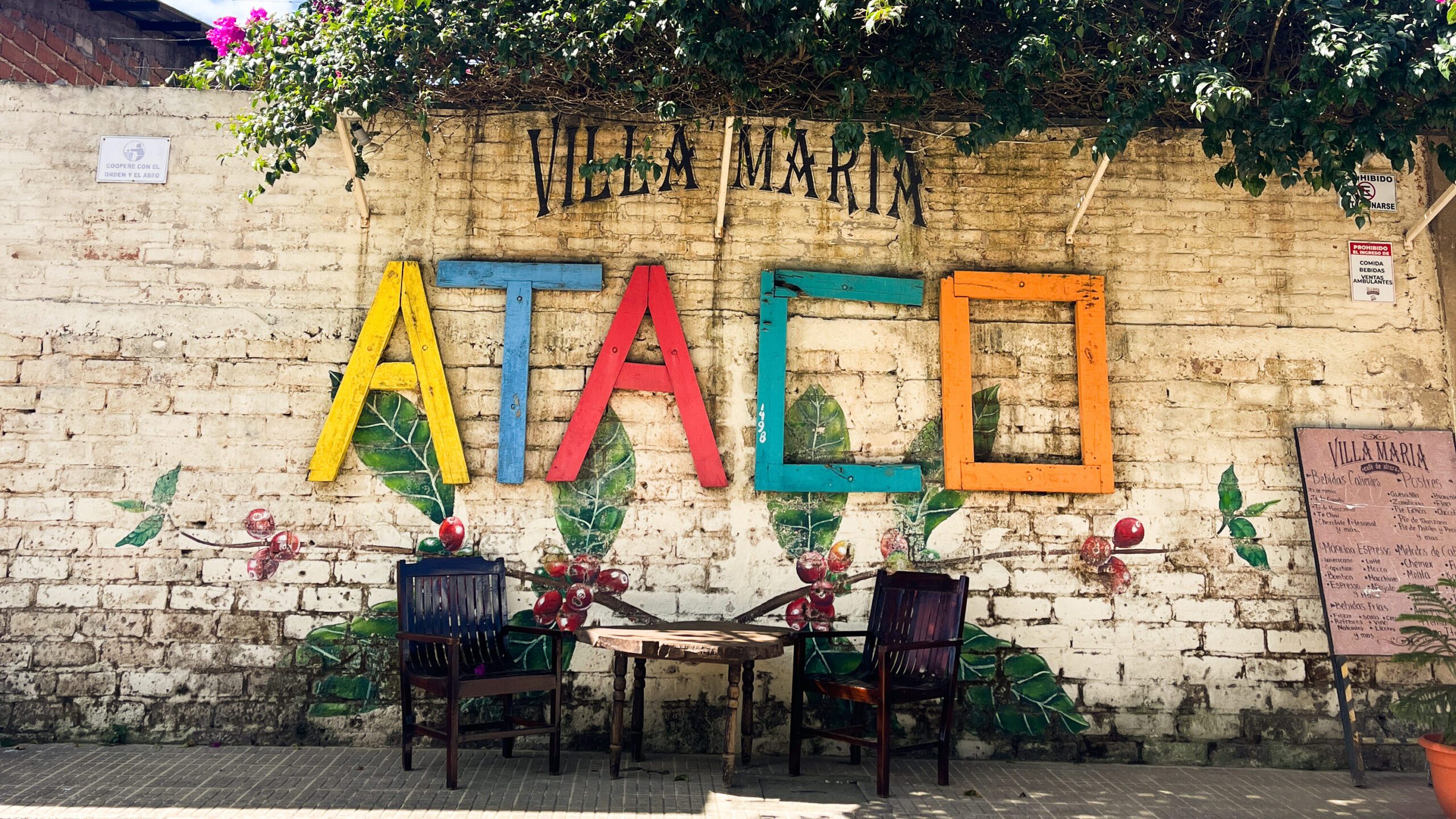
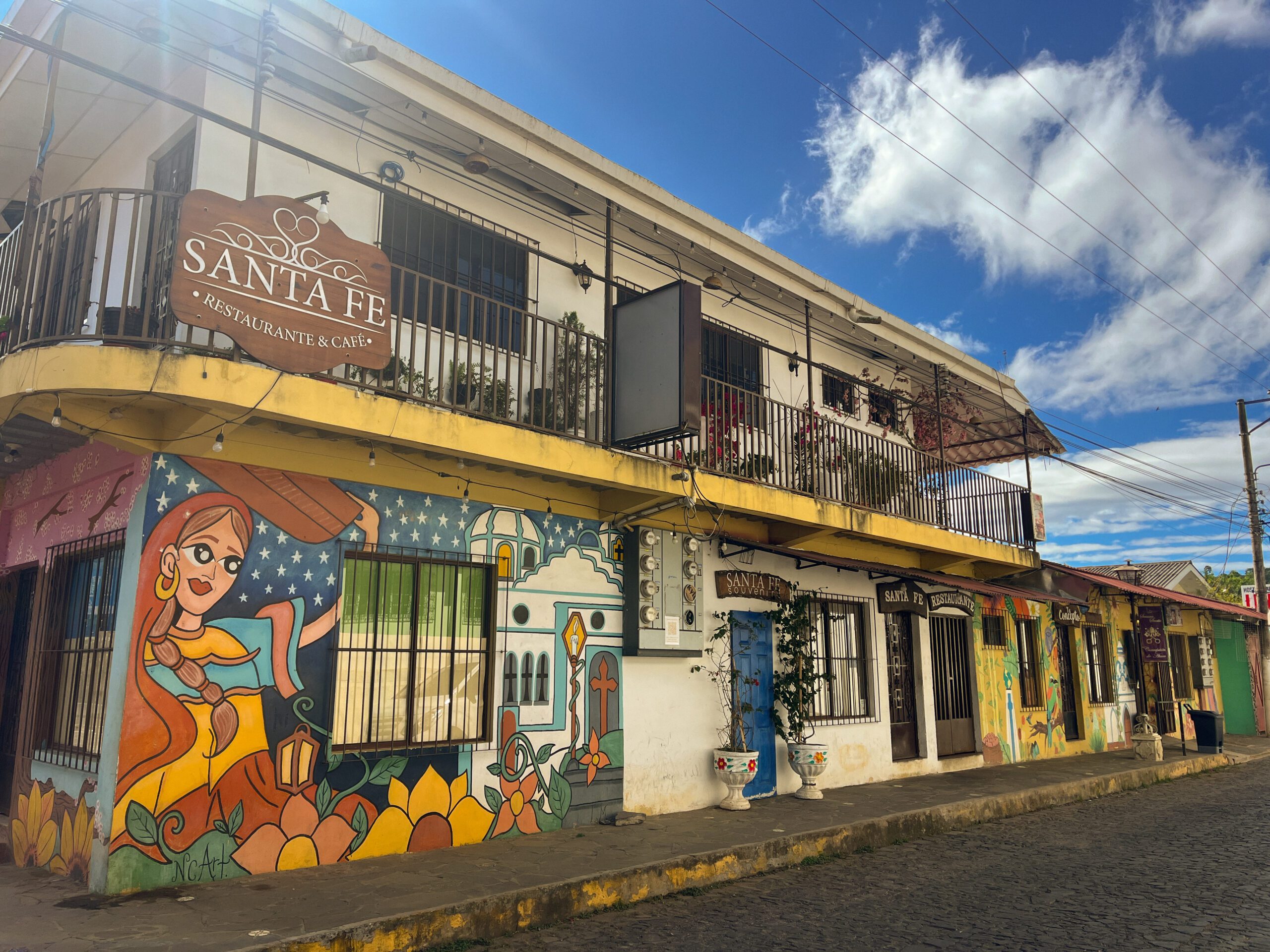
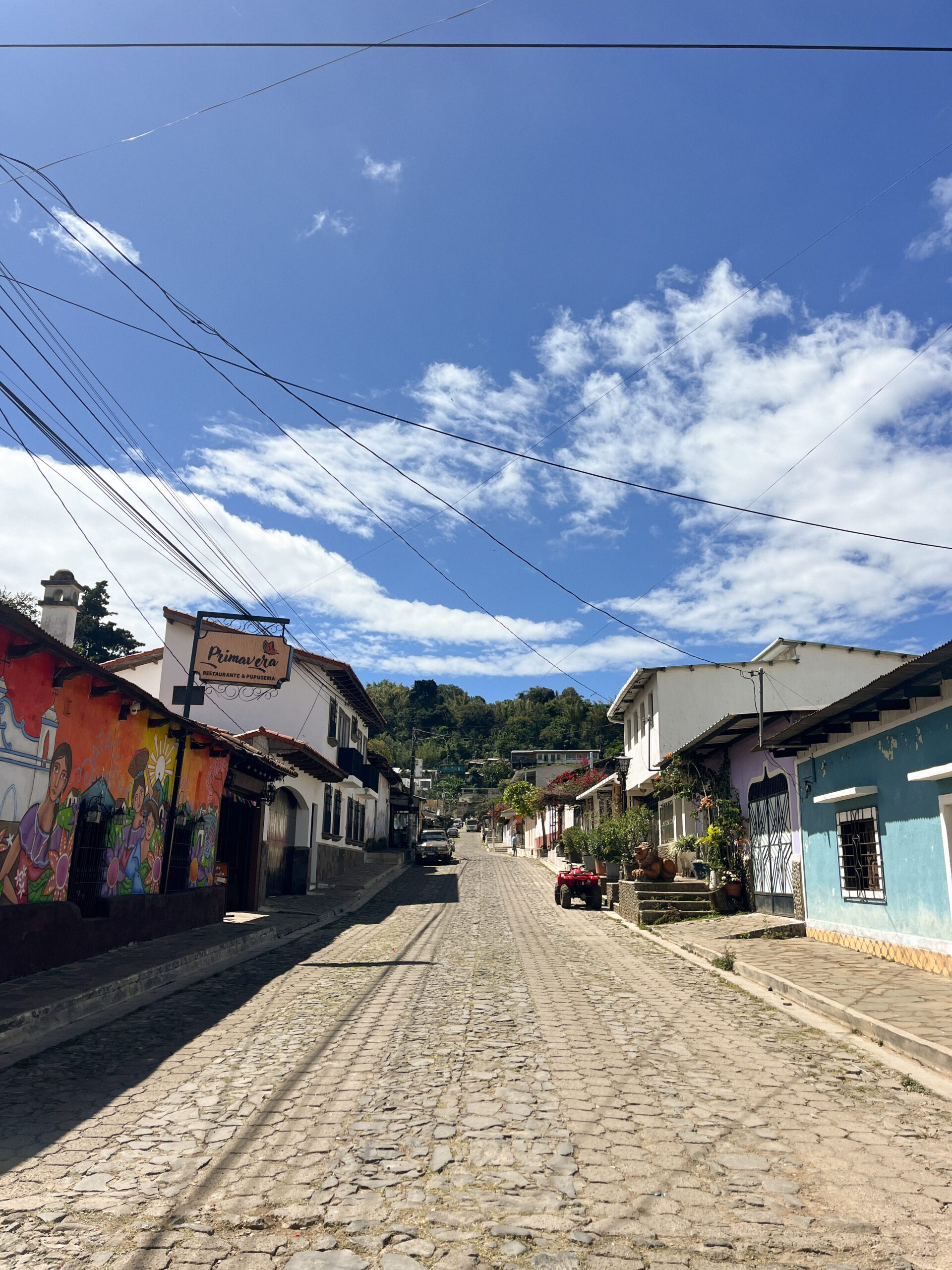
Ahuachapán
Ahuachapán is the largest town on Ruta de las Flores and just as Sonsonate, it’s more seen as a gateway to the route and often skipped for the smaller more famous towns. However, here is also things to see and discover.
At the center of the town is the Parque Concordia which is a plaza surrounded by colonial buildings and local life. Just beside it lays the Iglesia de Nuestra Señora de la Asunción with its white facade and twin towers glowing beautifully at sunset.
Ahuachapán is mostly famous for its natural hot springs and geothermal sites. A short drive away is the Termales de Santa Teresa and Alicante hot springs, where you can relax and enjoy the hot springs surrounded by beautiful nature.
As well as the other towns along the route, Ahuachapán has colorful murals and mosaics around town as well as coffee culture and Salvadoran life. For a beautiful view, head to the Mirador de la Piedra de los Compadres, a viewpoint tied to a local legend, offering views of the valleys below.
Things To Do In Ahuachapán
- Parque Concordia: The city’s central park with lively atmosphere.
- Iglesia de Nuestra Señora de la Asunción: Beautiful colonial church in the heart of town.
- Termales de Santa Teresa or Alicante Hot Springs: Enjoy the geothermal hot springs and relax at the spa.
- Mirador de la Piedra de los Compadres: Hike up for beautiful views and learn about the local legend.
- Murals and Coffee Shops: Explore the streets to see Ahuachapán’s murals and stop by local cafés.
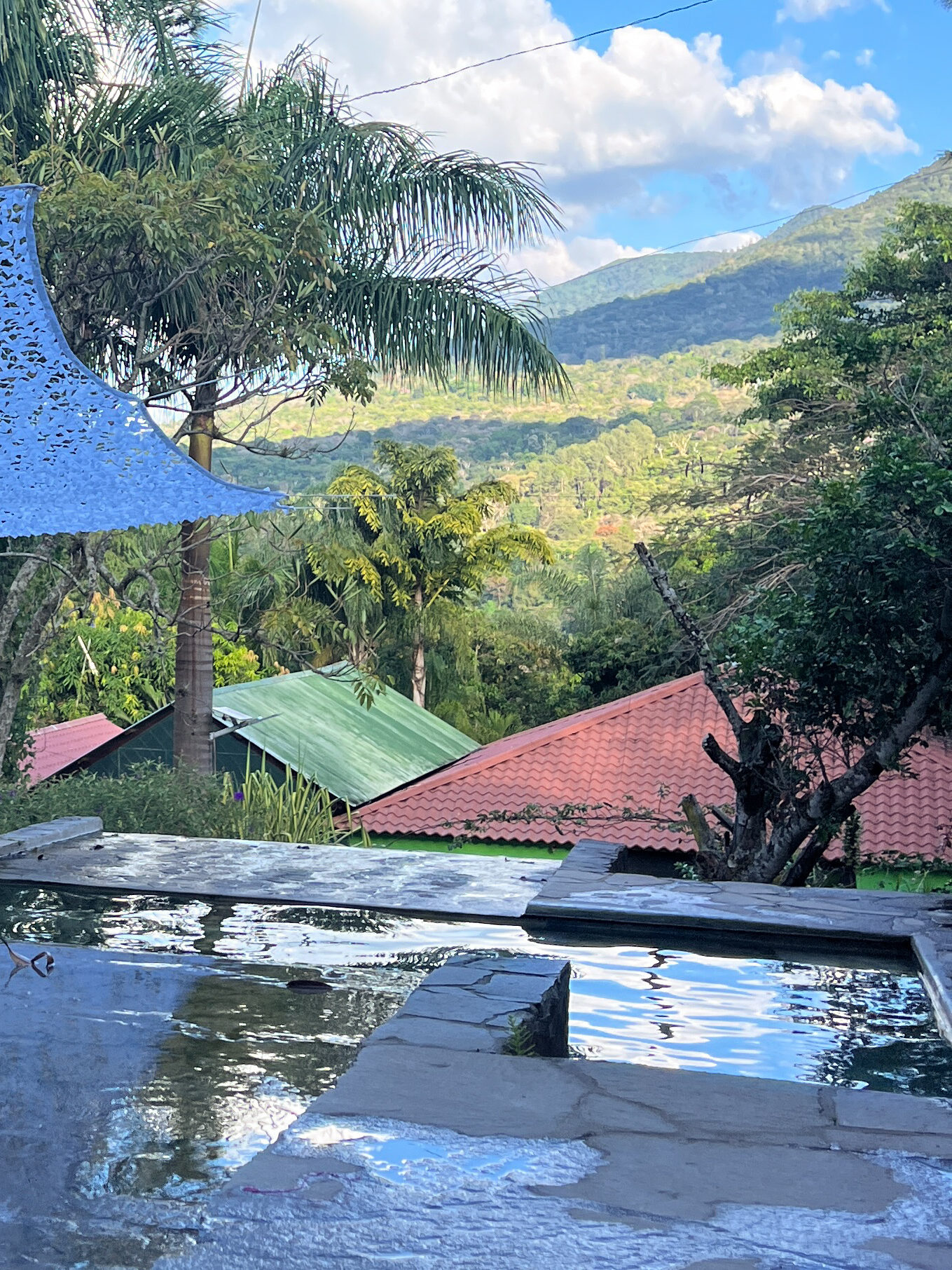

Where to stay
For most travelers, it makes sense to base yourself in one of the larger towns along the Ruta de las Flores, Juayúa or Ataco. Both of these towns have a good selection of accommodations, restaurants and other practical services such as supermarkets and ATMs.
We spent time in both Juayúa and Ataco during our trip. Juayúa, located near the middle of the route is ideal if you want easy access to major attractions. Its central location makes getting around the other towns easy without spending too much travel time.
Ataco, on the other hand sits toward the northern end of the route. If you base yourself here, you’ll likely be traveling more often to reach other towns, as there aren’t as many attractions immediately around it.
If your schedule allows, splitting your stay between the two towns is a great option. A couple of nights in Juayúa for southern activities, then a few nights in Ataco to explore the northern part of the route. This way, you get the best of both worlds without long daily transfers. For tips on finding cheap accommodation, see our post How To Find Cheap Accommodations While Traveling.
Top Attractions
Waterfalls
- Los Chorros de la Calera: Easy walk from Juayúa with natural pools perfect for a swim.
- Salto de Malacatiupán: Beautiful warm thermal waterfall near Ahuachapán.
- Juayúa 7 Waterfalls: Hike through 7 beautiful waterfalls just outside Juayúa.
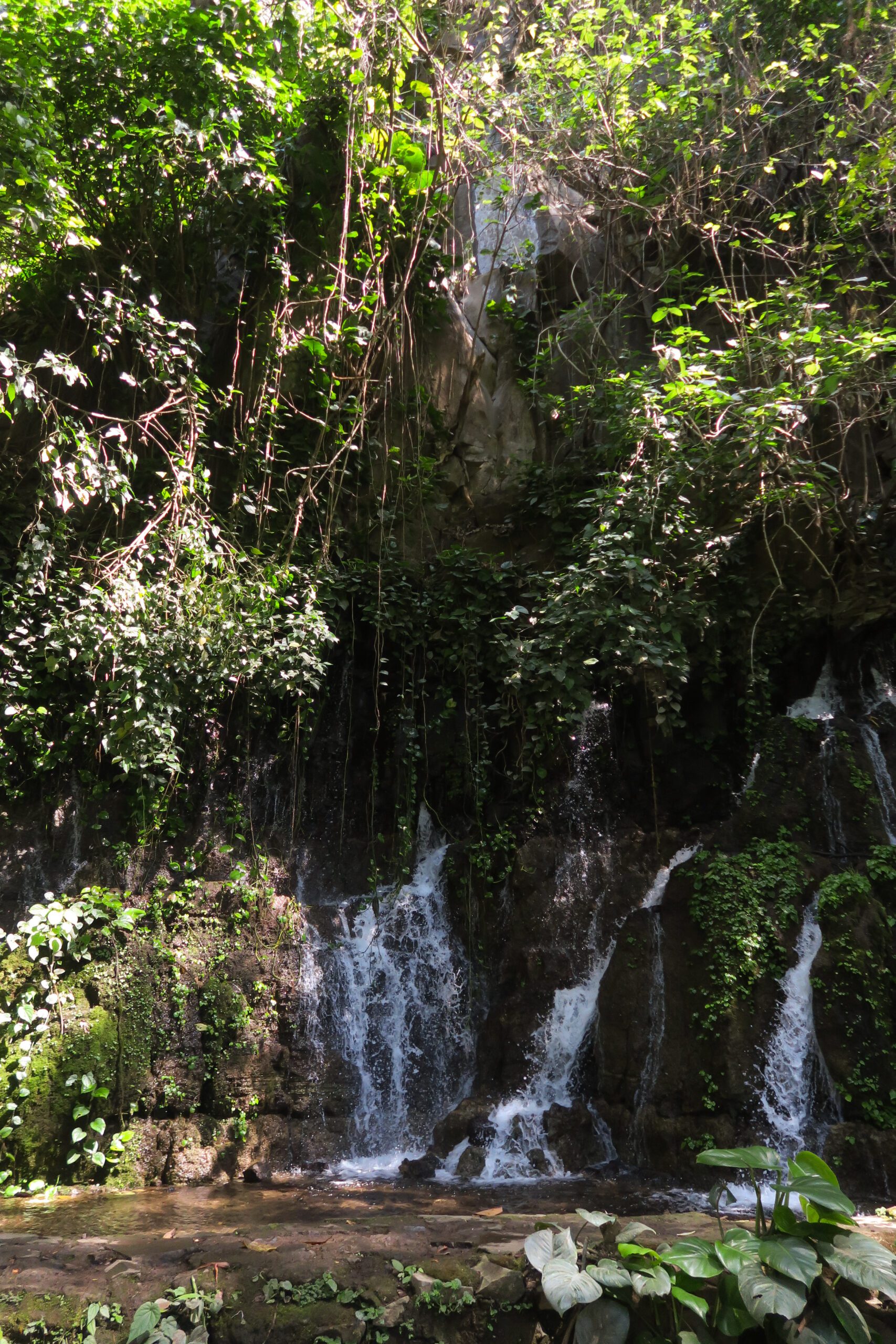


Adventure
- Café Albania: Zipline bike, rainbow slide and maze just outside Apaneca.
- Cerro Verde National Park: Hike beautiful trails with panoramic views near Apaneca.
- Hot Springs: Relax in the Termales de Santa Teresa or the nearby Alicante hot springs. It’s just a short drive from Apaneca and great places to relax.
Food & Drinks
- Juayua Food Festival: Local and international dishes, weekends only.
- Coffee Tours: Coffee tasting and farm visits, mainly in Apaneca.
- Cafes & Street Food: Try pupusas, fresh fruit juices and artisanal chocolate.
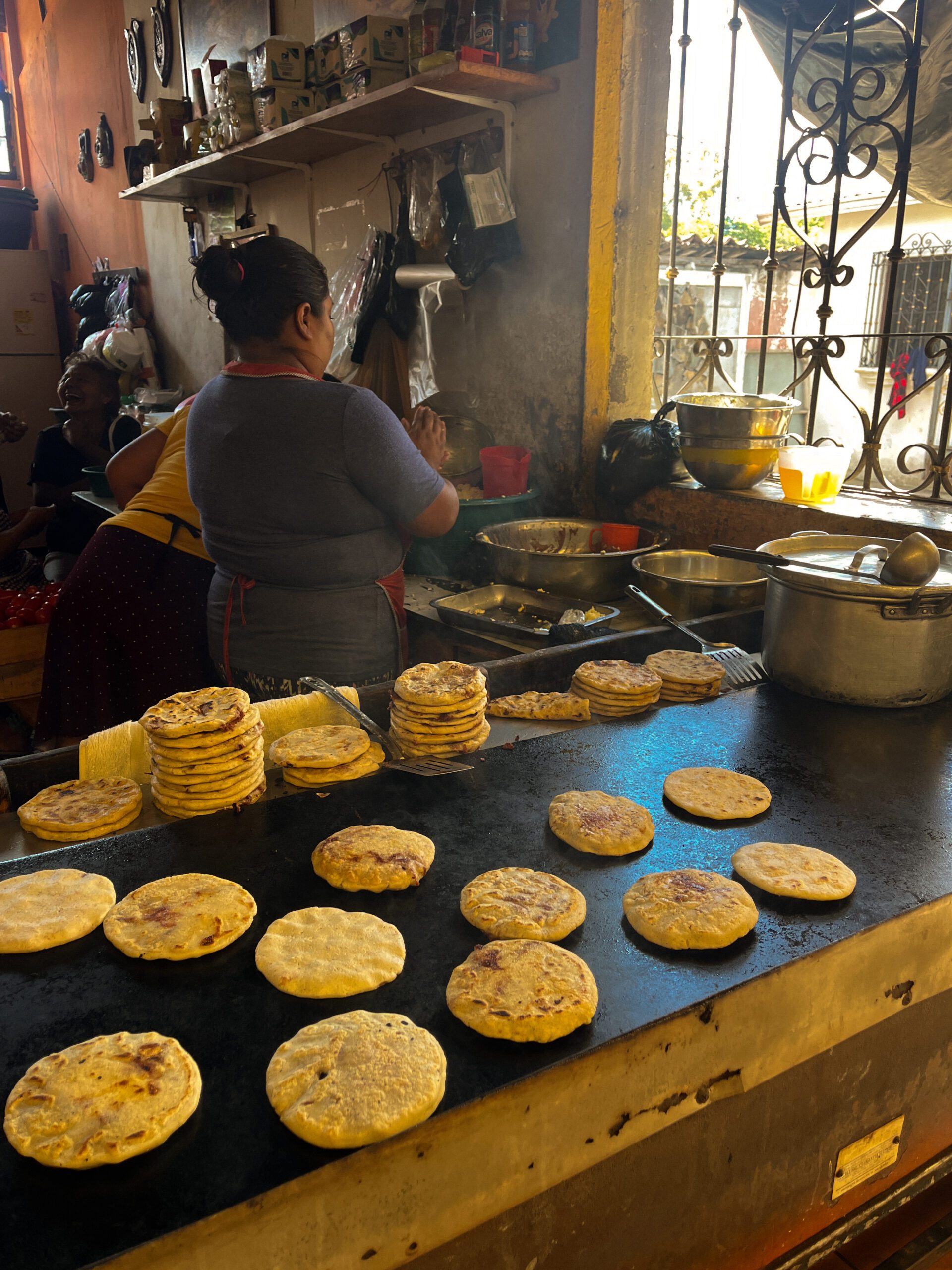

Culture & Art
- Murals in Ataco: Over 20 colorful street murals.
- Artisan Shops: Tule weaving in Nahuizalco, pottery in Salcoatitan.
- Festivals: Semana Santa, local music events and flower festivals in spring.
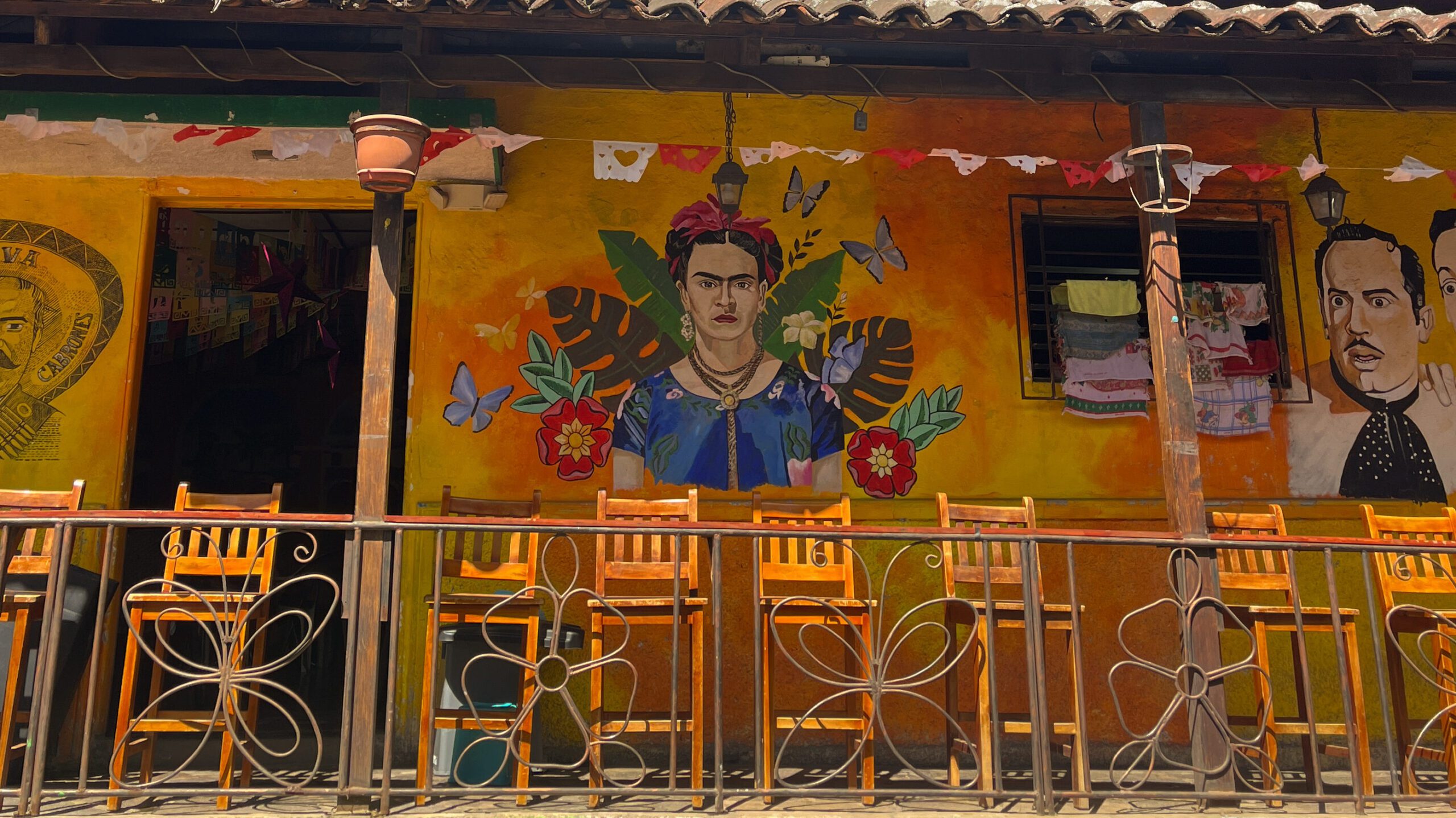
Ruta de las Flores Safety & Travel Tips
- Safety: The area is indeed considered safe, especially compared to other parts of El Salvador. Small towns like Juayúa, Ataco, and Apaneca have friendly locals. Petty crime is rare but normal travel precautions (watch belongings, avoid poorly lit areas at night etc) are still recommended.
- Cash & ATMs: Many small shops, cafés, markets and local stalls are cash-only. ATMs are mostly in the main towns, so always carry some cash.
- Language: English is not widely spoken, so basic Spanish or a translation app is very useful.
- Packing: Even in warm months, it can get cold, so make sure to bring layers, a jacket and long pants.
- Trail & Road Safety: Some waterfall paths are uneven or slippery, and roads can slow in the rainy season (May–October).
- Respect Local Culture: Be mindful of local customs and artisan work. Be polite when taking photos or negotiating prices and respect the locals.
Final Thoughts About Ruta de las Flores
We really loved Ruta de las Flores, and it’s definitely a destination to include on your El Salvador itinerary. It’s, in our opinion, one of the country’s most charming places, with each town having its own vibe. Markets, colorful street art, peaceful plazas, and artisan shops. As well as the surrounding hills and valleys, make it even more special and add a touch of adventure.
Ruta de las Flores truly has something for everyone. Coffee tasting, beautiful streets and stalls, waterfalls and thermal pools. It’s very different from the more touristy spots, with a relaxed pace and an up-close look at local life.
If you get the chance, try to spend at least a few nights here. In that way you can enjoy it all without rushing. Ruta de las Flores deserves time to really experience and soak it all in.


